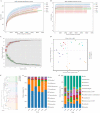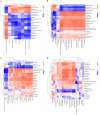Effects of Milk Replacer-Based Lactobacillus on Growth and Gut Development of Yaks' Calves: a Gut Microbiome and Metabolic Study
- PMID: 35771011
- PMCID: PMC9431445
- DOI: 10.1128/spectrum.01155-22
Effects of Milk Replacer-Based Lactobacillus on Growth and Gut Development of Yaks' Calves: a Gut Microbiome and Metabolic Study
Abstract
The gut microbiota and its metabolic activities are crucial for maintaining host homoeostasis and health, of which the role of probiotics has indeed been emphasized. The current study delves into the performance of probiotics as a beneficial managemental strategy, which further highlights their impact on growth performance, serologic investigation, gut microbiota, and metabolic profiling in yaks' calves. A field experiment was employed consisting of 2 by 3 factorial controls, including two development stages, namely, 21 and 42 days (about one and a half month), with three different feeding treatments. Results showed a positive impact of probiotic supplements on growth performance by approximately 3.16 kg (P < 0.01) compared with the blank control. Moreover, they had the potential to improve serum antioxidants and biochemical properties. We found that microorganisms that threaten health were enriched in the gut of the blank control with the depletion of beneficial bacteria, although all yaks were healthy. Additionally, the gut was colonized by a microbial succession that assembled into a more mature microbiome, driven by the probiotics strategy. The gut metabolic profiling was also changed significantly after the probiotic strategy, i.e., the concentrations of metabolites and the metabolic pattern, including enrichments in protein digestion and absorption, vitamin digestion and absorption, and biosynthesis of secondary metabolites. In summary, probiotics promoted gut microbiota/metabolites, developing precise interventions and achieving physiological benefits based on intestinal microecology. Hence, it is important to understand probiotic dietary changes to the gut microbiome, metabolome, and the host phenotype. IMPORTANCE The host microbiome is a composite of the trillion microorganisms colonizing host bodies. It can be impacted by various factors, including diet, environmental conditions, and physical activities. The yaks' calves have a pre-existing imbalance in the intestinal microbiota with an inadequate feeding strategy, resulting in poor growth performance, diarrhea, and other intestinal diseases. Hence, targeting gut microbiota might provide a new effective feeding strategy for enhancing performance and maintaining a healthy intestinal environment. Based on the current findings, milk replacer-based Lactobacillus feeding may improve growth performance and health in yaks' calves.
Keywords: Lactobacillus; gut development; metabolomics; microbiome; yak calf.
Conflict of interest statement
The authors declare no conflict of interest.
Figures







Similar articles
-
The Effect of Lactobacillus sakei on Growth Performance and Intestinal Health in Dogs: Gut Microbiota and Metabolism Study.Probiotics Antimicrob Proteins. 2024 Dec;16(6):2116-2131. doi: 10.1007/s12602-023-10160-9. Epub 2023 Sep 23. Probiotics Antimicrob Proteins. 2024. PMID: 37740881
-
Microbiome Analysis Reveals the Attenuation Effect of Lactobacillus From Yaks on Diarrhea via Modulation of Gut Microbiota.Front Cell Infect Microbiol. 2021 Feb 16;10:610781. doi: 10.3389/fcimb.2020.610781. eCollection 2020. Front Cell Infect Microbiol. 2021. PMID: 33665171 Free PMC article.
-
Metagenomic analysis for exploring the potential of Lactobacillus yoelii FYL1 to mitigate bacterial diarrhea and changes in the gut microbiota of juvenile yaks.Microb Pathog. 2024 Jan;186:106496. doi: 10.1016/j.micpath.2023.106496. Epub 2023 Dec 9. Microb Pathog. 2024. PMID: 38072228
-
Effects of Probiotics on Gut Microbiota: An Overview.Int J Mol Sci. 2024 May 30;25(11):6022. doi: 10.3390/ijms25116022. Int J Mol Sci. 2024. PMID: 38892208 Free PMC article. Review.
-
Probiotic roles of Lactobacillus sp. in swine: insights from gut microbiota.J Appl Microbiol. 2017 Mar;122(3):554-567. doi: 10.1111/jam.13364. J Appl Microbiol. 2017. PMID: 27914202 Review.
Cited by
-
Hydroxytyrosol Alleviates Intestinal Oxidative Stress by Regulating Bile Acid Metabolism in a Piglet Model.Int J Mol Sci. 2024 May 21;25(11):5590. doi: 10.3390/ijms25115590. Int J Mol Sci. 2024. PMID: 38891778 Free PMC article.
-
Comparative Genomics of Limosilactobacillus reuteri YLR001 Reveals Genetic Diversity and Probiotic Properties.Microorganisms. 2024 Aug 10;12(8):1636. doi: 10.3390/microorganisms12081636. Microorganisms. 2024. PMID: 39203478 Free PMC article.
-
Effect of Bacillus subtilis isolated from yaks on D-galactose-induced oxidative stress and hepatic damage in mice.Front Microbiol. 2025 Mar 5;16:1550556. doi: 10.3389/fmicb.2025.1550556. eCollection 2025. Front Microbiol. 2025. PMID: 40109966 Free PMC article.
-
Effects of lactic acid bacteria isolated from Tibetan chickens on the growth performance and gut microbiota of broiler.Front Microbiol. 2023 Jul 20;14:1171074. doi: 10.3389/fmicb.2023.1171074. eCollection 2023. Front Microbiol. 2023. PMID: 37547685 Free PMC article.
-
Metagenomic analysis provides bases on individualized shift of colon microbiome affected by delaying colostrum feeding in neonatal calves.Front Microbiol. 2022 Nov 1;13:1035331. doi: 10.3389/fmicb.2022.1035331. eCollection 2022. Front Microbiol. 2022. PMID: 36386713 Free PMC article.
References
-
- Qiu Q, Zhang G, Ma T, Qian W, Wang J, Ye Z, Cao C, Hu Q, Kim J, Larkin DM, Auvil L, Capitanu B, Ma J, Lewin HA, Qian X, Lang Y, Zhou R, Wang L, Wang K, Xia J, Liao S, Pan S, Lu X, Hou H, Wang Y, Zang X, Yin Y, Ma H, Zhang J, Wang Z, Zhang Y, Zhang D, Yonezawa T, Hasegawa M, Zhong Y, Liu W, Zhang Y, Huang Z, Zhang S, Long R, Yang H, Wang J, Lenstra JA, Cooper DN, Wu Y, Wang J, Shi P, Wang J, Liu J. 2012. The yak genome and adaptation to life at high altitude. Nat Genet 44:946–949. doi:10.1038/ng.2343. - DOI - PubMed
-
- Long RJ, Dong SK, Wei XH, Pu XP. 2005. The effect of supplementary feeds on the bodyweight of yaks in cold season. Livest Prod Sci 93:197–204. doi:10.1016/j.livprodsci.2004.08.016. - DOI
Publication types
MeSH terms
LinkOut - more resources
Full Text Sources

